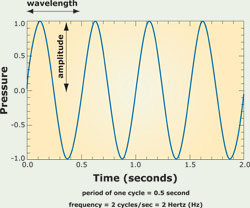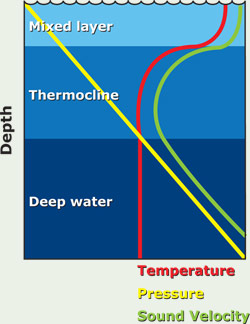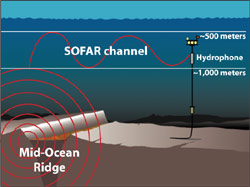|
Expedition 12 Hot Topic: The Scoop on Sound Under water, it's difficult to communicate! The basic components of a sound wave are frequency, wavelength, and amplitude. In this example of a sound wave, the period of one cycle of this wave is 0.5 seconds, and the frequency of this wave is 2 cycles per second or 2 Hertz (Hz). Click images for a larger view. These two waves have the same frequency but different amplitudes. These two waves have the same amplitude but different frequencies. Images above based on NOAA's Ocean Explorer Have you ever tried to talk to a friend in a pool—while you were both under water? If so, whatever you said probably sounded like an inaudible string of garbly “gloughs” that made you giggle so hard you had to pop up for a breath of air. Although a pool conversation (if you can call it that) proves that sound travels through water, it also proves that our vocal chords don’t transmit sound that well in the water. That’s why scuba divers usually use hand signals to communicate with each other. Scientists studying the ocean use much more sophisticated methods to communicate under water using sound. Sound travels in the form of waves, as light does. The neat thing about sound is that scientists can transform information into sound waves and send it over great distances. Scientists use sound to send and retrieve information from undersea robots, buoys, and other ocean tools, and they are always working hard to improve sound-based technology. Ocean acoustics, the study of sound in the sea, is a rapidly growing field of research today. The history of using sound to “communicate” in the sea goes all the way back to Leonardo da Vinci, the famous Renaissance Italian scientist (and painter, and writer, and inventor…the list goes on) who died nearly 500 years ago. Historians say he once stuck a long tube in the ocean to listen for a faraway ship and later designed an underwater breathing apparatus. In modern times, studying how sound travels in the sea really took off during World War II, when the navies used sound to track submarines. Catch a wave Picture a long roller-coaster-like sound wave, with top-rounded peaks and U-shaped troughs (bottoms). Sound waves have three main characteristics: frequency, wavelength, and amplitude. Wavelength is the distance between two peaks of the sound wave. Amplitude is the height of the “bump,” or the “loudness” of the sound (Think “amp” on a stereo!). The third part of a sound wave—frequency—is important for our autonomous underwater vehicles (AUVs), Puma and Jaguar, on this expedition. Frequency is the number of pressure waves that pass by a reference point per unit time; it is measured in Hertz per second (Hz/sec). Musicians call this “pitch.” The shorter the wavelength (distance between the peaks) is, the more pressure waves you can fit into a given time slot, so the higher the frequency—and vice versa. Humans hear sound waves with frequencies between 20 to 20,000 Hz. Anything above 20,000 Hz is called “supersonic,” which means it is even faster than the speed of sound. Dogs can hear these frequencies, whereas humans cannot. Cats such as pumas and jaguars—the names of our AUVs on this cruise—can hear even higher frequencies, enabling them to hear even the slightest squeak from a mouse in the wild. Lots of military aircraft and even the Space Shuttle can travel at supersonic speeds—literally “breaking the sound barrier.” Depending on their frequency, sound waves can travel over short distances or all the way around the world. The lower the frequency (and longer the wavelength), the farther sound waves can travel through water. For our purposes of communicating with Puma and Jaguar, that distance may be several thousands of meters away, and scientists aboard the Knorr will use sound waves at a frequency of 8 to 12 kHz—which is what a bunch of car keys sound like if you jingle it.
|
||
Mailing List | Feedback | Glossary | For Teachers | About Us | Contact
© 2010 Dive and Discover™. Dive and Discover™ is a registered trademark of Woods
Hole Oceanographic Institution






